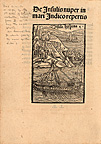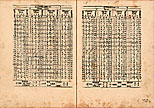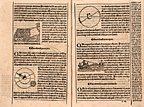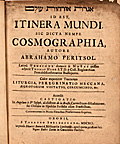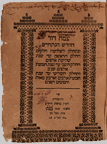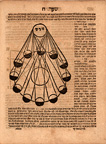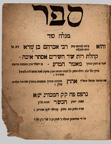Jews and the Dissemination of Geographical Knowledge The arrival in the West Indies of the three ships of Columbus is variously understood as a triumph for Spaniards, Genoese, Italians, or for Europe as a whole, but the entire endeavor rests upon a foundation of Islamic, Jewish, and Classical science. In particular, Abraham Zacuto developed astronomical tables, almanacs, and maps, while Levi ben Gerson is credited with the invention of the sea-quadrant or Jacob’s staff, used to guide marine courses. The year of discovery in 1492 was also the seminal year of the Sephardic diaspora, when Spanish Jews were required to convert to Catholicism or to leave Spain. Much of the population moved on to Portugal or found homes on the Mediterranean littoral. Columbus’s first crew included several conversos, or Spanish-Jewish converts to Christianity, notably the interpreter, Luis Torres. Importantly, three conversos in the Spanish court were influential in securing royal approval for the controversial expedition. When it became apparent that “new” lands lay to the west rather than the tip of Asia, Jewish writers joined other European intellectuals in speculation as to the character and history of that place. |
||
1. Theodor de Bry. America, part 5, Frankfurt [1595]. Columbus appears in Theodor de Bry's edition derived from the second part of Girolamo Benzoni's book, Historia del mondo nuovo. Efforts by some researchers to establish a secret Jewish heritage for Columbus have remained unproven, but his voyages bear strong Jewish overtones, from the identities of some crew members, key conversos in the Spanish court, and the pattern of scientific inquiry that helped make the voyages possible. |
|||
2. Christopher Columbus. De insulis inuentis, [Basel J. Wolff, after 29 Apr. 1493]. This text was translated from Senor por que se que aureis plazer de la grand vitoria, Barcelona, 1493. The Library possesses seven of the nine early editions of the letter. The Basel edition is represented here in facsimile. Columbus’s letter to the Court of Spain, outlining the importance of his discovery, was addressed to Santangel, the chancellor of Aragon, one of three important conversos in the royal court. Others were Gabriel Sanchez, the royal treasurer, and Juan Cabrero, the king’s chamberlain. |
|||
3. Abraham ben Samuel Zacuto. Almanach perpetuu[m], Venice: Petrus Liechtenstein, 1502. Zacuto’s Almanach, translated by José Vizinho from a Hebrew manuscript, is open to the page that shows the position of the moon in the year of the discovery of America. Abraham Zacuto was one of the most important geographers and cosmographers in the age of Columbus. His works were well known to Columbus, in Salamanca, and generally all over Europe. Curiously, the editor of this Latin edition of Zacuto’s Almanach seems to be at certain points very skeptical about what real knowledge Zacuto had of the subject: “that author did not entirely understand what he wrote about”–Cum ille autor salva pace non intellexerit a fundamento quod scripserit. |
|||
4. Bible. Old Testament. Psalms. Polyglot. Psalterium. [Genoa]: Petrus Paulus Porrus, 1516. This Genoa Psalter seems to have been the first polyglot work ever published. The title, text, and colophon are in five languages, Hebrew, Latin, Greek, Arabic, and Aramaic, along with notes in Latin, edited by Agostino Giustiniani, Bishop of Nebbio. In Psalm 19:4, Giustiniani has inserted in the notes the first printed account of the life of Christopher Columbus, together with a narrative of his second voyage. Porro, the master-printer of Turin, came to Genoa expressly for the purpose of this project, at the behest of the editor. The press run consisted of 2,000 copies on paper and 50 on vellum. John Carter Brown bought a copy printed on paper in 1846, but sometime before 1865 he acquired one of the rare copies printed on vellum. This is also the second book printed in Arabic, and the only book printed in Genoa in the first quarter of the sixteenth century. |
|||
5. Tratado da sphera. Lisbon: Germão Galharde, 1537. Pedro Nunes was the most renowned of the converso scientists, and the greatest Portuguese mathematician of the sixteenth century. In 1547 he was named chief cosmographer of Portugal. This book begins with his translation into Portuguese of Joannes de Sacro Bosco’s Sphaera mundi, an essay on the sun and moon by Georg Aunpekh, and the first chapter of Ptolemy’s Geographia. Nunes then launches into his own original writing on the science of navigation, establishing a new standard for navigation manuals. |
|||
6. Abraham ben Mordecai Farissol. [Iggeret Orhot 'Olam]. Venice : Giovanni di Gara, 1586. Gift in 1955 by 21 Brown graduates led by Samuel Temkin, ’19, in honor of Rabbi William G. Braude of Temple Beth-El of Providence. |
|||
7. Abraham ben Mordecai Farissol. [Igeret orhot shalem [i.e.,’olam]], id est, Itinera mundi, sic dicta nempe. Oxford: Henry Bonwick, 1691. |
|||
8. Abraham ben Mordecai Farissol. Iggeret orhot 'olam. [Prague : Israel Landau, 1793]. Purchased with the assistance of the Bloomingdale Fund. |
|||
9. David ben Solomon Gans. [Sefer Tsemakh David he-hadash]. |
|||
10. David ben Solomon Gans. [Neḥmad ṿe-na’im]. [Jessnitz : Israel bar Avraham, 1743]. This work, published after Gans’s death, is valuable to an understanding of his role as an inquiring scholar and one of the greatest scientists of the Renaissance. This is the complete edition of his masterpiece, much improved from an incomplete text, which was published in 1608. Here, Gans corrects his earlier mis-statement about the discovery of America, saying that it was Columbus who made the American discovery in 1492, not Amerigo Vespucci in 1533, as he had claimed. Acquired with the assistance of the Littauer Fund. |
|||
11. Mosheh bar Avraham. [Sefer Tela'ot Mosheh]. [Halle : Mosheh bar Avraham], 472 [i.e., 1711 or 1712]. This geographical work, with text in Yiddish in Hebrew characters, contains the third description of America to appear in Yiddish. The accounts are based on the works of Abraham Farissol and Gedaliah Ibn Yahya (1697). Mosheh bar Avraham grew up in Nikolsburg and Prague and converted to Judaism in Amsterdam. Purchased with the assistance of the JCB Associates. |
|||
12. David Nieto. [Matteh Dan] y Segunda parte. … Compuesto por el H.H.R. David Nieto en Londres año 5474. [London: Thomas Ilive, 1714]. The great Italian rabbi, David Nieto, was the haham and chief rabbi of the London Sephardi community from 1700 to 1728. The Matteh Dan, here in its Spanish version, is a powerful tract for a firm Jewish orthodoxy and defense of the Oral Law against the innovations of free-thinking former Marranos. Here, Nieto describes the various zones into which geographers have divided the globe, and focuses on their conclusion that human life is possible only in one of them, the Temperate Zone. This conclusion conflicts with Isaiah 45:18, which says “He created it [the World] not a waste[land], He formed it to be inhabited.” Nieto asks how this statement could be true if only a fifth of the globe could be inhabited? He concludes that biblical scholars couldn’t be blamed for not knowing better, since all of them were born in the Temperate Zone. How, then, could they attain a knowledge of God’s omnipotence and providence manifest in things of which they had never heard? Nowadays, Nieto continues, we know from places like Peru that human life is possible in the Torrid Zone, because the lack of rain there is compensated for by a superabundance of dew and other factors. Acquired with the assistance of the Harper Fund. |
|||
13. Joseph ha-Kohen. [Divrei ha-Yamim]. [Amsterdam, 1733]. The “History of the Kingdom of Spain and of the Ottoman Empire” is one of the foremost productions of the Genoese Jewish writer Joseph ha-Cohen, a native of Provence who wrote in Voltaggio, a small village above Genoa, in the second half of the sixteenth century. Cohen was one of the few Jewish historians in the Renaissance (and later) who dealt with non-Jewish themes. Several scattered references to the New World–its discovery, names, and wildlife–are contained in the last part of the section devoted to Spain. Acquired with the assistance of the Bloomingdale Fund. |
|||
14. Isaac Abraham Euchel. [ha- Measef le-shenat ... /... `al yede anashe heverat dorashe ever be-Kenigsberg]. Koenigsberg, Breslau, & Berlin, 1783-1797. |
|||
15. Aaron ben Solomon Emerich Gomperz. [Sefer megaleh Sod]. Gomperz was the first Prussian Jew to obtain a medical degree. A disciple of Moses Mendelssohn, he was learned in both traditional and secular studies. Like many of his contemporaries, his knowledge of science was probably based on Hebrew translations of older scientific works. Gomperz wrote that the ancient Greeks thought that all regions near the equator and North Pole were devoid of civilization. But in his own time, he observed, since sailing was much easier, men reached the equator itself. Although it was very hot–so much so that the people were black–the region was nevertheless civilized and the Dutch and English were always traveling there for trade. Others, he said, traveled far north, near the North Pole, and there too found civilized peoples. “In this manner was discovered, in the year 1490 [sic!], just prior to the Spanish Inquisition, such a vast land spanning across both sides of the equator that they called it the fourth quarter of the world; others called it the New World. That is the land of America, and it too was found civilized.” |
|||
16. Menahem Mann ben Solomon, ha-Levi, Amelander. [She'erit Yisra'el]. “The Remnant of Israel” was probably originally published in Amsterdam in 1743. Amelander maintained that one of Isaiah’s prophecies, “for the Lord will redeem the remnant of his people from Assyria … and from the islands of the sea” (Isaiah 11:11), refers to the islands of the Western Hemisphere and quotes passages from the Scriptures to show that there were Jews settled in America in ancient times. The interpretation of this passage in Isaiah is made possible by the fact that the term “yam” in Hebrew may mean “sea” or “west”. Hence, the translation of the verse according to this interpretation would be: “For the Lord will redeem the remnant of his people from Assyria … and the islands of the West.” Purchased with the assistance of the Bloomingdale Fund. |
|||
17. Barukh Linda. [Reshit limudim]. Berlin, 1788. With text in Hebrew and explanations in Latin and Yiddish, this textbook on the natural sciences was issued by the first school founded in Germany by the Haskalah (Enlightenment) movement. The school, Hinnukh Ne’arim, had the aim of reshaping Jewish life by introducing Jewish youth to secular education. Emphasizing physics and geography, the book offers information on all the peoples of the world—there are a thousand million inhabitants and all of them have a different appearance. Brazilian Indians are among those given a brief description. Gift of Yosef Goldman. |
|||
18. [Seder harei olam]. [Frankfurt an der Oder, 1792]. This text, in Yiddish with Hebrew characters, describes the mountain ranges of the world, among which are those of South America, familiar to a European audience because of the storied mines of Peru. Purchased with the assistance of the Feldman Fund. |
|||
19. Jehiel ben Solomon Heilprin. [Seder ha-dorot]. [Karlsruhe : F.W. Lotter and M. Macklott, 1769]. |
|||
Exhibition prepared by Dennis Landis, Curator of European Books.




